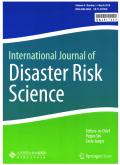青藏高原退行性融塌期地面冰消融三维数值模拟及其水文生态系统响应
IF 2.9
2区 地球科学
Q2 GEOSCIENCES, MULTIDISCIPLINARY
引用次数: 0
摘要
青藏高原多年冻土区频繁发生的退行性融雪滑坡(RTSs)会对当地地表造成重大破坏,造成物质损失,并对该地区的基础设施和生态系统构成威胁。然而,由于缺乏对RTS开发过程中复杂的水热过程的了解,地面冰消融和水文生态系统响应的定量评估受到限制。在此基础上,建立了青藏高原北麓河流域多年冻土带的三维水-热耦合数值模型,包括冰-水相变、热交换、质量输运以及活动层与空气之间的参数化热交换。基于标定的水热模型,结合电阻率层析成像测量和样品分析结果,提出了一种估算地下冰融化量的方法。模拟结果表明,该模型能较好地反映RTS的实际水热状态,并能较好地评价地表冰消融和以浊度为代表的总悬浮泥沙变化。2011 - 2021年间,滑塌区内模拟地冰消融最大的年份是2016年,总计492 m3,并诱发了逆演化,尤其是在RTS的顶壁。2021年融水季节积水浊度较高,分别为28和49。模拟的地表冰消融和浑浊事件与气候变暖和变湿高度相关。研究结果为评估RTS对基础设施和环境的影响提供了一种有价值的方法,尤其是在气候变化的背景下。本文章由计算机程序翻译,如有差异,请以英文原文为准。
Three-Dimensional Numerical Modeling of Ground Ice Ablation in a Retrogressive Thaw Slump and Its Hydrological Ecosystem Response on the Qinghai-Tibet Plateau, China
Abstract Retrogressive thaw slumps (RTSs), which frequently occur in permafrost regions of the Qinghai-Tibet Plateau (QTP), China, can cause significant damage to the local surface, resulting in material losses and posing a threat to infrastructure and ecosystems in the region. However, quantitative assessment of ground ice ablation and hydrological ecosystem response was limited due to a lack of understanding of the complex hydro-thermal process during RTS development. In this study, we developed a three-dimensional hydro-thermal coupled numerical model of a RTS in the permafrost terrain at the Beilu River Basin of the QTP, including ice–water phase transitions, heat exchange, mass transport, and the parameterized exchange of heat between the active layer and air. Based on the calibrated hydro-thermal model and combined with the electrical resistivity tomography survey and sample analysis results, a method for estimating the melting of ground ice was proposed. Simulation results indicate that the model effectively reflects the factual hydro-thermal regime of the RTS and can evaluate the ground ice ablation and total suspended sediment variation, represented by turbidity. Between 2011 and 2021, the maximum simulated ground ice ablation was in 2016 within the slump region, amounting to a total of 492 m 3 , and it induced the reciprocal evolution, especially in the headwall of the RTS. High ponding depression water turbidity values of 28 and 49 occurred in the thawing season in 2021. The simulated ground ice ablation and turbidity events were highly correlated with climatic warming and wetting. The results offer a valuable approach to assessing the effects of RTS on infrastructure and the environment, especially in the context of a changing climate.
求助全文
通过发布文献求助,成功后即可免费获取论文全文。
去求助
来源期刊

International Journal of Disaster Risk Science
GEOSCIENCES, MULTIDISCIPLINARYMETEOROLOGY-METEOROLOGY & ATMOSPHERIC SCIENCES
CiteScore
6.50
自引率
7.50%
发文量
63
审稿时长
13 weeks
期刊介绍:
The International Journal of Disaster Risk Science (IJDRS) provides a pioneering platform for researchers and practitioners aiming at greater resilience and integrated risk governance in view of local, regional, and global disasters. IJDRS breaks new ground in research about disaster risks by connecting in-depth studies of actual disasters and of specific practices of disaster risk management with investigations of the global dynamics of disaster risks and theories and models relevant for advanced integrated risk governance.
 求助内容:
求助内容: 应助结果提醒方式:
应助结果提醒方式:


